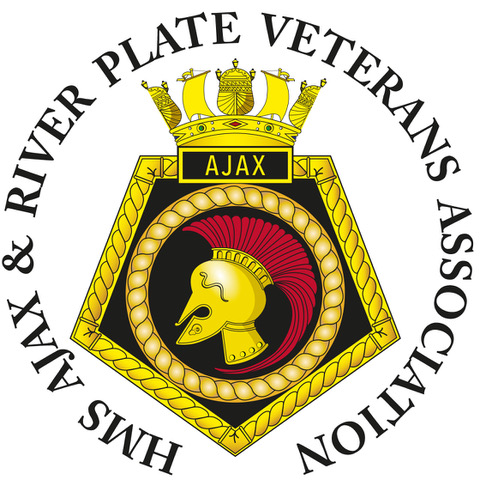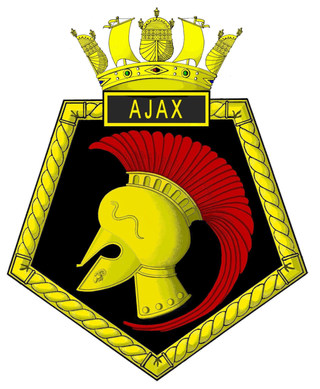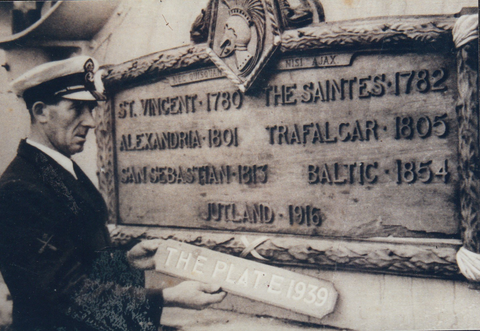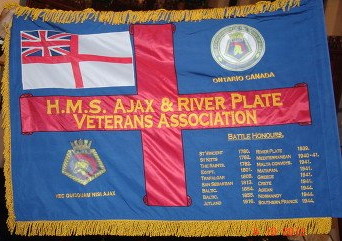Ajax & Battle Honours
SHIP'S MOTTO
“NEC QUISQUAM NISI AJAX”
The literal meaning of the motto is “Not anyone but Ajax”. The meaning of the phrase can only be understood by knowing the context of the quotation. The motto is a shortened form of the Latin sentence meaning “No one is able to overcome Ajax but Ajax himself”. The fall of Ajax is impossible without his consent; he is in control of himself. For us the meaning of the motto is that Ajax is superior to all or “NONE BEFORE AJAX”
HISTORY OF THE NAME AJAX
The name Ajax (Greek Aias) is said to arise from the appearance of an eagle (Greek aietos) sent by Zeus in response to the prayers of Hercules to give Telamon, King of Salamis, a brave son.
Ajax was a legendary hero of ancient Greece and the most famous hero, after Achilles, of the Trojan War. He was a man of giant stature. He engaged Hector in single combat. Their fight was ended by the heralds. The two heroes exchanged gifts: Hector received a belt from Ajax and Hector gave Ajax a sword. It was with the belt of Ajax that Achilles dragged Hector. Ajax also, with the aid of Athena, rescued the body of Achilles, killed by Paris, from the hands of the Trojans.
Agamemnon awarded Achilles’ armour to Odysseus. Enraged by this decision, Ajax planned an assault on the Greek troops. However, Athena, the goddess of wisdom, drove Ajax temporarily insane and he attacked a flock of sheep instead. After recovering his senses he was so ashamed that he killed himself with the sword Hector had given him. From his blood sprung a red hyacinth with the first two letters of his Greek name, AI, on the petals. Even in his afterlife in the Underworld, Ajax was still angry and refused to speak with Odysseus.
Ajax was a tutelary hero of the island of Salamis where he had a temple and an image, and where the festival of Aianteia was celebrated in his honour.
The ship's ‘Ajax’ refers to ‘Ajax the Great’ to distinguish him from another Ajax known as Oilean Ajax or Ajax the Lesser.
SHIP’S BADGE
The HM Ship’s Badge features the ancient Greek helmet of Ajax with two symbols thereon: a ram’s head on the jaw piece, a reference to Ajax’s moment of madness when he slaughtered a flock of sheep; and his reputed birthplace on the Island of Salamis represented by a snake.
The badge is surmounted by sterns of men-of-war, each with three poop lanterns, and square sails each spread on a mast and yard, fully fitted and sheeted home, the ships and sails being positioned alternately. The crown is gold with the centre stone a red ruby. The stones either side are green emeralds and those on the extremities, blue sapphires. The studs either side of the emeralds are white pearls.
Badges were first officially recognised by the Admiralty in 1918 although banners and shields had been displayed long before this. Until 1976 badge shapes depended upon the vessel type: circular for capital ships (battleships and battlecruisers); pentagonal for cruisers; shield for destroyers and submarines and diamond for aircraft carriers. Thereafter badges were circular.
The cruiser Ajax features a pentagonal badge and the frigate Ajax a round one.
BATTLE HONOURS
HOW THEY WORK
Several lists with varying number of Battle Honours for Ajax exist and differing names for individual Awards.
“Badges and Battle Honours of H.M. Ships” by Lt. Cdr. K.V. Burns D.S.M., R.N. published in 1986 ISBN 0-907771-26-2 explains the confusion.
Prior to Admiralty Order 2565 of 1954, when they issued an official list of Fleet Actions and Campaigns for which Battle Honours had been awarded, honours were displayed on ships solely on the authority of the commander – presumably the more awarded the better he looked! They could and were awarded for involvement in any conflict, regardless of degree of involvement, by the captain.
Not only did the Admiralty issue an official list but they also removed a large number previously displayed awards and going through that list every single one of Ajax’s honours is omitted!
However, the author lists every Ajax Battle Honour with subtle differences to those held by the Association. The image of Ajax's on-board Honours Board differs still, as does the Association's Standard, showing the difficulties associated with researching the matter.
| K. V. Burns' List | Dates | Association Archive List | Dates |
|---|---|---|---|
| St Vincent | 1780 | St Vincent | 1780 |
| St Kitts | 1782 | Martinique | 1780 |
| The Saints | 1782 | Chesapeake | 1781-82 |
| Egypt | 1801 | St Kitts | 1782 |
| Trafalgar | 1805 | Saintes | 1782 |
| San Sebastian | 1813 | Nile | 1801 |
| Baltic | 1854-55 | Calders | 1805 |
| Jutland | 1916 | Trafalgar | 1805 |
| River Plate | 1939 | San Sebastian | 1813 |
| Mediterranean | 1940-41 | Baltic | 1854 |
| Malta Convoys | 1941 | Jutland | 1916 |
| Matapan | 1941 | River Plate | 1939 |
| Greece | 1941 | Mediterranean | 1940-42 |
| Crete | 1941 | Matapan | 1941 |
| Aegean | 1944 | Greece&Crete | 1941 |
| Normandy | 1944 | Malta Convoys | 1940-42 |
| South of France | 1944 | Aegean | 1944 |
| D-Day Landings | 1944 | ||
| South of France | 1944 |



